Enabling Relations
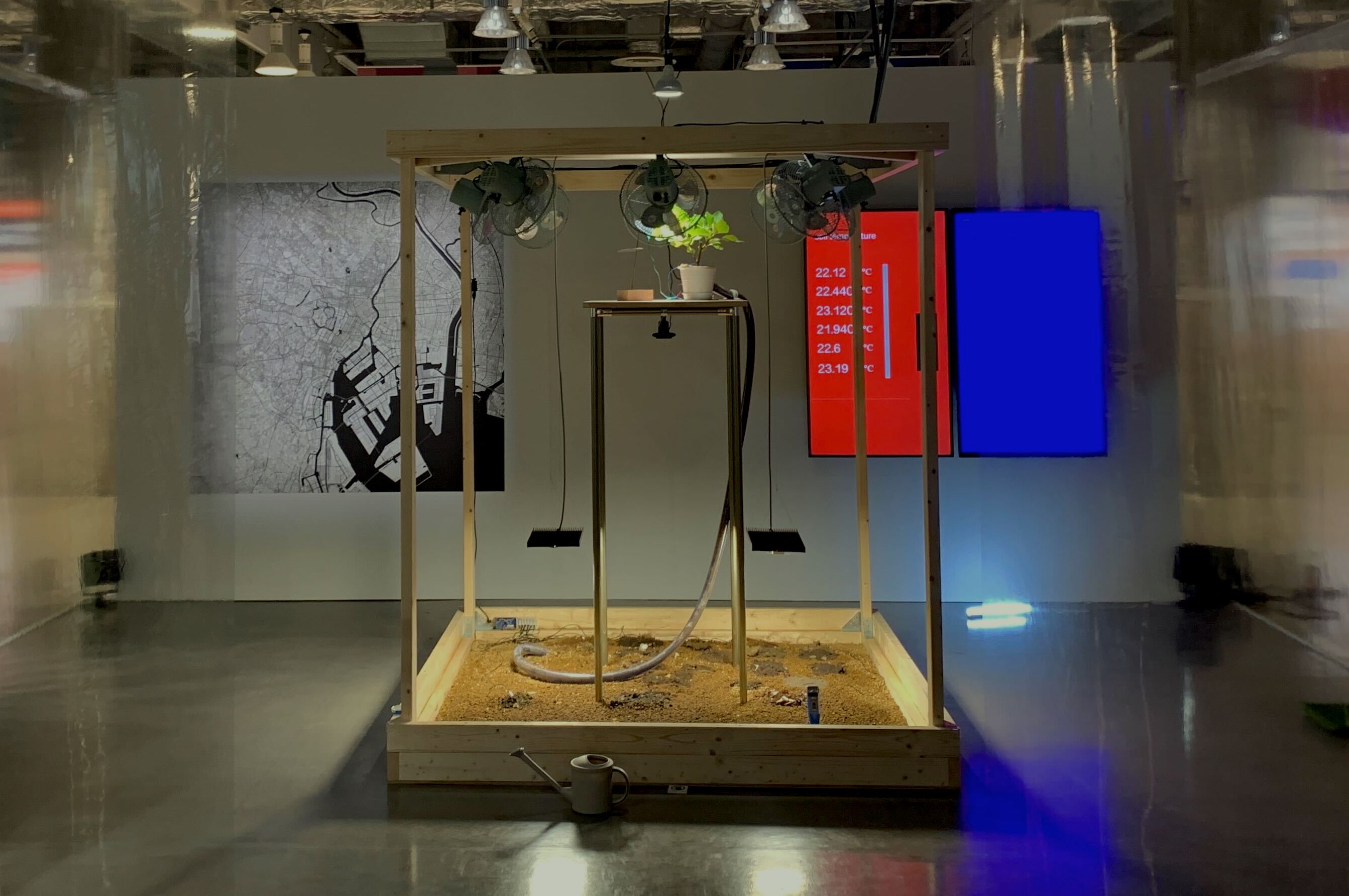
OVERVIEW
The bodies of living organisms are constantly engaged in relationships with various species. Not only through predation and pollination, as seen with bees, but also through the effects and networks of fungi in the soil on trees, which have garnered recent attention. The project “Enabling Relations” experiments with whether modern technology can create new kinds of relationships in the physical world among plants and insects, similar to how humans have achieved remote interactions via the internet. Initially, it explores the relationships between street trees in Tokyo and elements such as soil, water, and airflow. Subsequently, it conducts experiments to see if plants in different locations can form a network. Additionally, it investigates whether human activities can engage with these ecosystems and seeks new ways of connection.
This project aims not merely to preserve nature as it traditionally exists but to upgrade it. Humans have extended their “bodies” using tools. Thus, it is conceivable that our bodies and technologies could use the vast network comprising all life and environmental elements as a tool, allowing the ecosystem itself to expand the possibilities of relationships (enabling). For such expansion, we need to develop new ’living technologies’ that can coexist with nature, moving away from traditional rigid technologies. This attempt serves as a starting point and aims to be a forum for discussion.
Enabling Relations Exhibition Details
In the exhibition space, various weeds grown in soil and sterilized soil are physically connected and left during the exhibition to observe how much the properties of the sterilized soil change. In the center of the space, beneath an altar-like setup, soil collected mainly from parks in Tokyo’s 23 wards is arranged roughly in the shape of a map. Sterilized black soil (representative of Tokyo’s topsoil) is placed between the soils, and after lighting that mimics natural sunlight and watering, the device observes what kind of vegetation occurs when soils from various fragmented parks are placed sufficiently close in the real world.

The importance of soil as a medium in plant relationships is evident not only through traditional means but also recent studies suggesting that touching leaves of different plants may transmit biopotential through the leaves, propagating information from one plant to another. The plants on the altar transmit biopotentials from plants located in downtown areas via the internet to the venue, recreating the state of leaves touching remotely.
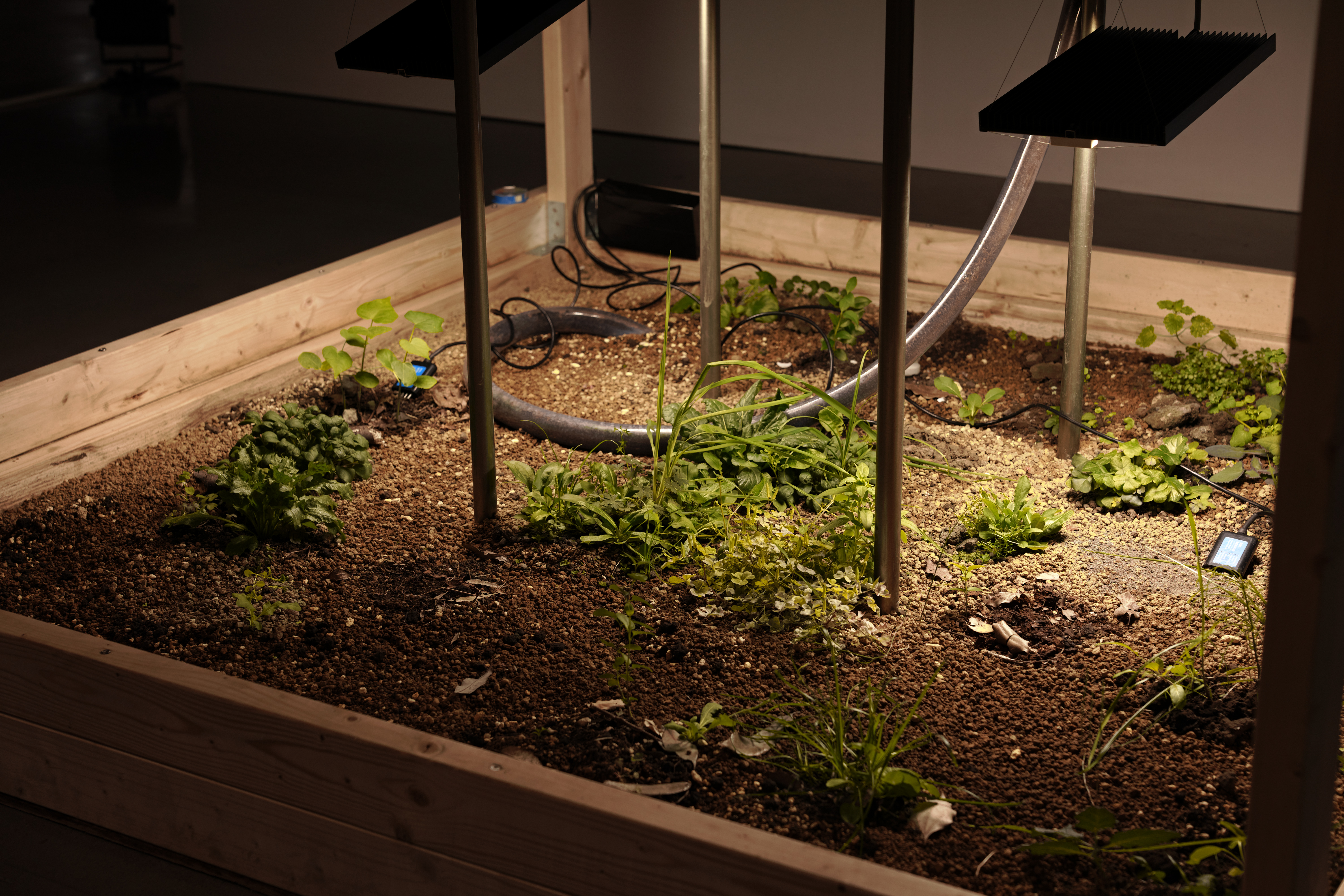
植物同士の関係性において重要な媒体は土だけではありません。近年、植物同士の葉が触れ合うことで、一方の植物からもう一方の植物へ葉に流れる生体電位をとおして情報が伝播しているのではないかという研究が発表されました。祭壇上に置かれた植物は、都心某所に置かれた植物の生体電位をインターネットを介し会場に送信し、会場の植物にその電位を受け渡すことで、遠隔でありながら植物の葉同士が触れている状態を再現したものです。
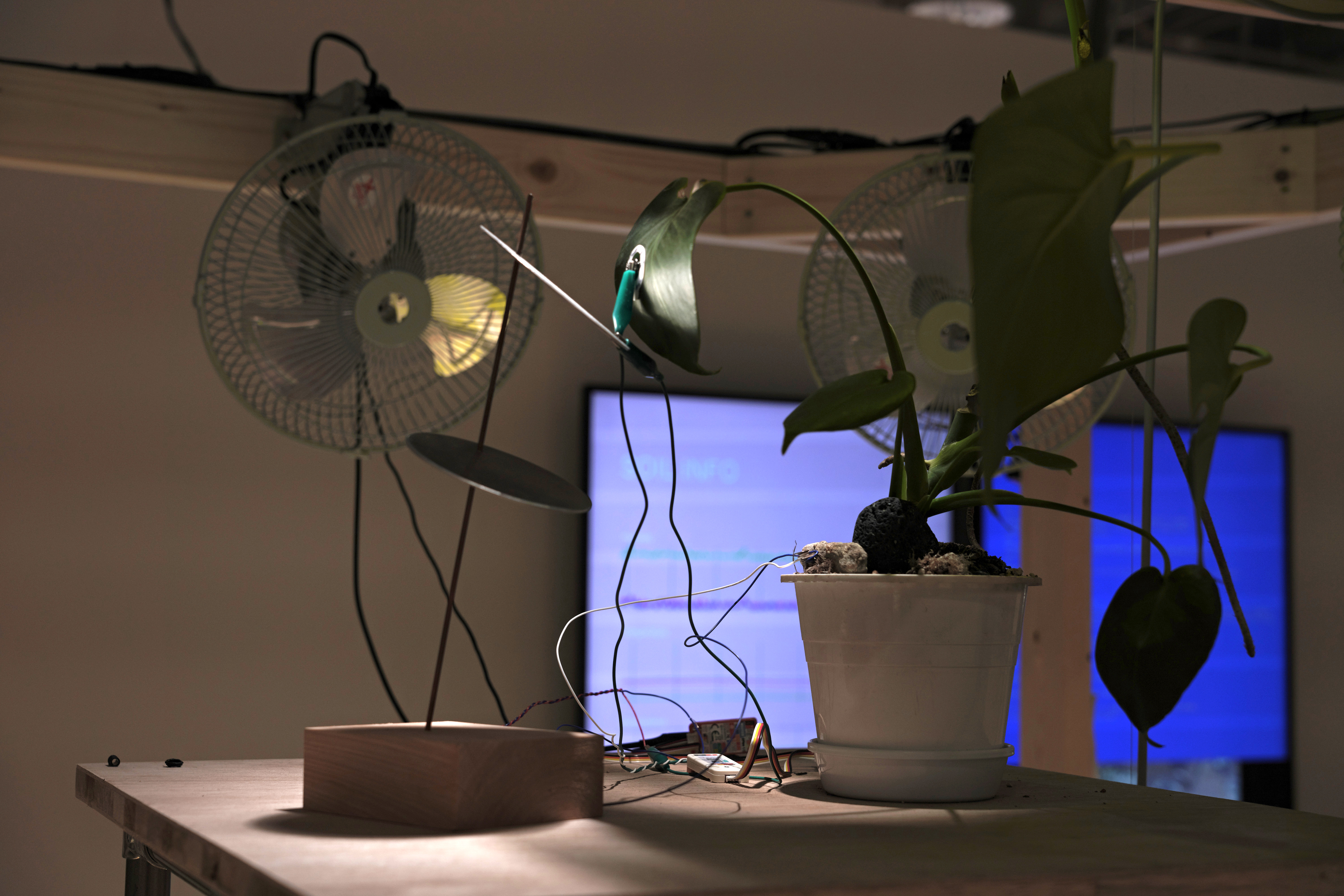
Additionally, devices around the area replicate the airflow at the location where the receiving plants are placed, effectively creating a kind of Virtual Reality for plants.
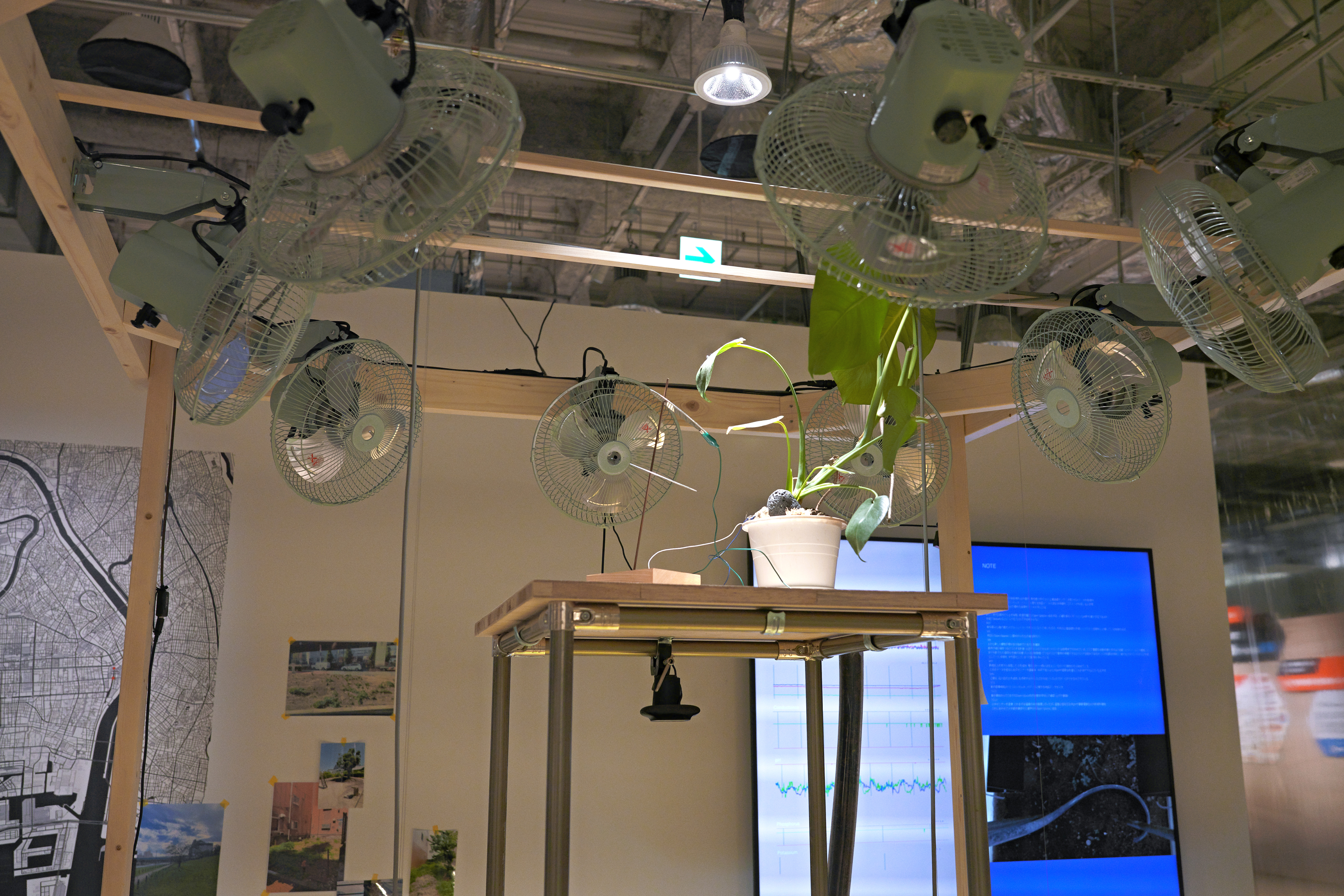
On the back wall of the left side of the exhibition space is a map centered on the venue in Yurakucho, Tokyo. This map will continually be updated with information about the natural state and soil collection sites in downtown Tokyo during the exhibition.
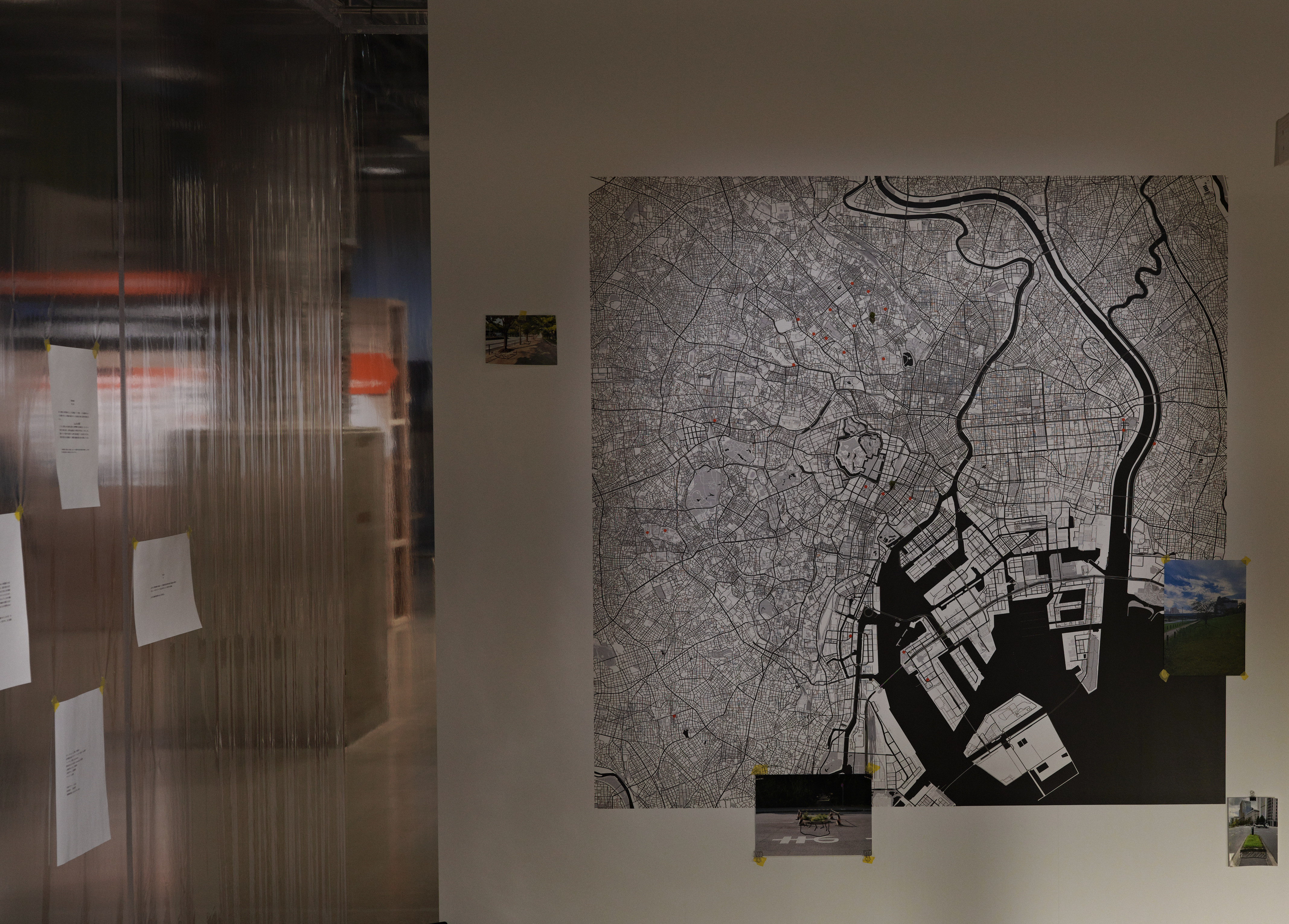
The right side of the space features an experimental notebook for the exhibition, accessible via the internet, allowing us to write from anywhere and updated throughout the exhibition.
The Concept Behind ‘Enabling Relations’
Soil as an Intermediary
植物はその根を通して、土中の微生物と相互作用していることが今から 100 年以上前に明らかになりました。この相互作用が起こる土壌空間 を根圏 (rhizosphere) とよびます。また近年では、森の中の木の根同士が土壌内に住む菌糸の力を借りてネットワーク(菌根ネットワーク)を 形成し、栄養や情報をやりとりすることで植生が頑強になるという仮説が世間を賑わせました。この菌根ネットワーク自体の有効性に関しては、 現時点でも議論が続けられている段階ですが、少なくとも植物と植物の「間」で土壌が共有されていることの有効性は多く示されています。そ して生態系においては、このような土壌中のネットワークのように「普段は目に見えない関係性」が重要な役割を担っています。
Urban Soil
一方、人のつくった都市ではどうでしょうか。日本の都市ではヒートアイランド現象対策や生物多様性回復の名目のもと、様々な緑化計画義務 に関する制度・条例が制定されています。東京都では、通称「自然保護条例(東京における自然の保護と回復に関する条例)」に基づき、一定 基準以上の敷地における新築・増改築の建物に対して、その敷地内(建築物上を含む)への緑化を義務付けています。また街路樹に関しても、 2006 年「街路樹の充実」事業以降、都内の街路樹本数は激増し、2016 年には 100 万本を超えました。一方で、このような条例のもと植えら れていく植物は、元々植物が育つことが出来ない未熟土壌、あるいは屋上緑化のようにそもそも土壌がなかった場所に外部から土を運搬して植 えられているという現状があります。つまり(明治神宮などの例を除けば)、現在の都内の土壌は細かく分断されている状態であると言えます。 明治神宮の森は、今から約 100 年前、当時最先端の造園学の理論を用いて、広大な荒れ地だった代々木の土地に 100 年後も森がその植生を変 えながらも自律的に生き続けるように計画、実践された人工の森です。現在では天然林と見紛うほどの森となっていますが、1915-20 年にかけ て全国からの献木を含めて合計 12 万本の常緑広葉樹を主とする苗木を植栽してから 50 年以上年月をかけて現在の森となったうえ、その土壌 環境はほぼ自然土壌であるという条件のもとにおいてこれだけの年月を必要としました。 それでは、土壌が分断された現在の東京において、ばらばらに植えられた植物たちは 100 年後も自律的に生き続ける「森」となることができ るのでしょうか。そのためには、土壌のつながりも含んだ、動的に変化する関係性を理解し、それに寄り添う技術をつくらなくてはいけません。
Enabling Relations
私たちはよく「人間と自然」というような言葉を用いますが、自然の立場からすると私たちの振る舞いも自然現象のひとつであり、生態系とい う「関係性」に含まれるひとつのノード(構成要素)です。そして、私たち自身もアクティブなノードとなって、この関係性を書き換えていく ことができます。 このプロジェクトの最終目標は従来の自然を保護することではなく、自然をアップグレードすることです。私たち人間は、道具を用いることで 自らの「身体」を拡張してきました。ならば、私たちの身体や技術を、生態系というあらゆる生命 / 環境によって構成される巨大なネットワー クそのものが道具として利用し、そして生態系自らが関係の可能性を拡張(可能化 : Enabling) していくこともありえるでしょう。その拡張の ためには旧来の固い技術から、自然と共存できるやわらかい「生命技術」を作り出す必要があります。ここでの試みはそのスタート地点であり、 議論の場となっていくことを目指しています。